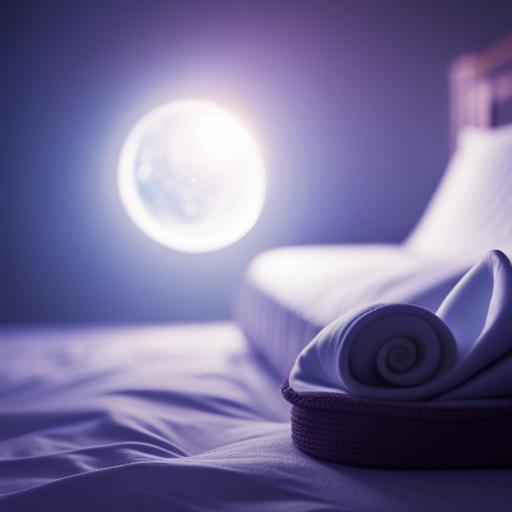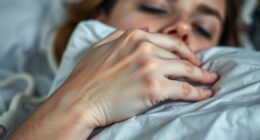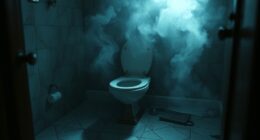Did you know that around 22 million Americans are affected by sleep apnea? As someone who struggles with this condition, I have personally felt the effects it has on my sleep quality and dream vividness. Sleep apnea is a prevalent sleep disorder marked by breathing pauses during sleep, usually accompanied by loud snoring. Continuous Positive Airway Pressure (CPAP) machines are commonly employed in treating sleep apnea by providing a constant airflow to keep the airways unobstructed.
However, when I don’t use my CPAP machine, I have noticed a significant increase in the vividness of my dreams. This phenomenon has piqued my curiosity, leading me to delve deeper into the science behind dreaming and its connection to sleep apnea.
In this article, we will explore the reasons why dreams become more vivid when CPAP is not used, including the impact of CPAP usage on dreaming, the science behind vivid dreams, emotional and psychological factors, hormonal changes, and other sleep disorders that contribute to dream intensity. Additionally, we will provide tips for managing vivid dreams without CPAP and emphasize the importance of seeking professional help and support.
Key Takeaways
- Not using a CPAP machine can lead to more intense and vivid dreaming, as the brain compensates for disrupted sleep by increasing dream activity during the REM stage.
- Factors influencing the vividness of dreams include sleep stage, emotional state, sleep environment, medications/substances, and sleep disorders.
- Dream recall is linked to sleep patterns, and not using a CPAP machine can disrupt sleep patterns and make dreams more memorable.
- Hormonal imbalances and certain medications can also impact dream intensity, and not using a CPAP machine can potentially lead to these imbalances and more vivid dreams.
Understanding Sleep Apnea and CPAP Machines
When you don’t use your CPAP machine, you may experience a heightened occurrence of vivid dreams.
Sleep apnea, a condition characterized by pauses in breathing during sleep, can disrupt the normal sleep cycle and lead to poor sleep quality. CPAP (Continuous Positive Airway Pressure) machines are commonly used to treat sleep apnea by delivering a constant stream of air to keep the airways open.
However, if you choose not to use your CPAP machine, there are alternative treatments available for sleep apnea. These include lifestyle changes such as weight loss, avoiding alcohol and sedatives before bed, and sleeping on your side instead of your back. Additionally, dental devices or surgery may be recommended in some cases.
It is important to note that sleep apnea is not just a nuisance; it is also linked to heart health. Untreated sleep apnea can increase the risk of high blood pressure, heart disease, and stroke. By not using your CPAP machine, you are potentially putting your heart health at risk.
Transitioning into the next section, the impact of CPAP usage on dreaming, it’s worth exploring how the use of a CPAP machine affects the vividness and content of dreams.
The Impact of CPAP Usage on Dreaming
Despite not using my CPAP machine, I find it coincidental that my dreams become remarkably vivid. The impact of CPAP usage on sleep quality is well-documented, and managing sleep apnea symptoms is crucial for overall well-being.
CPAP machines work by delivering a constant flow of air pressure to keep the airways open during sleep, ensuring proper breathing and preventing apnea episodes. By not using my CPAP, I am not effectively managing my sleep apnea, which can result in fragmented sleep and reduced oxygen levels. Interestingly, this lack of treatment seems to have a direct effect on the vividness of my dreams.
Research suggests that untreated sleep apnea can lead to more intense and vivid dreaming. This could be due to the brain compensating for the disrupted sleep by increasing dream activity during the REM (rapid eye movement) stage. Additionally, the decreased oxygen levels and fragmented sleep can cause changes in brain chemistry, leading to more vivid and memorable dreams.
Understanding the science behind vivid dreams can provide valuable insights into the relationship between sleep apnea and dream quality, further emphasizing the importance of using CPAP therapy for managing sleep apnea symptoms.
The Science Behind Vivid Dreams
Imagine yourself experiencing incredibly vivid and lifelike dreams, as if you were transported to another world while you sleep. This phenomenon is not uncommon and can be attributed to various scientific factors. Dream interpretation is a fascinating field that aims to understand the meaning behind our dreams. It explores the symbols, emotions, and experiences that manifest in our subconscious minds during sleep.
One aspect of vivid dreaming is the concept of lucid dreaming. Lucid dreaming occurs when the dreamer is aware that they are dreaming and can actively participate and manipulate the dream environment. This heightened level of consciousness allows individuals to experience dreams with greater intensity and control.
To better understand the science behind vivid dreams, let’s take a look at the following table:
| Factors Influencing Vivid Dreams | ||||
|---|---|---|---|---|
| Sleep Stage | Emotional State | Sleep Environment | Medications/Substances | Sleep Disorders |
Each of these factors can contribute to the intensity and vividness of dreams. For example, certain sleep stages, such as REM (rapid eye movement) sleep, are known to be associated with more vivid dreaming. Additionally, emotional states, sleep environment, medications/substances, and sleep disorders can all influence the content and intensity of dreams.
Understanding the science behind vivid dreams can help us further explore the impact of not using a CPAP machine on dream intensity.
Lack of CPAP and Dream Intensity
Not using my CPAP machine is like being trapped in a foggy haze, where my dreams lose their vibrant colors and become dull and lifeless. It’s fascinating how the lack of CPAP can impact the intensity of my dreams.
When I don’t use my CPAP, I tend to experience more vivid dreams compared to when I use it consistently. This relationship between the absence of CPAP and dream intensity can be attributed to several factors:
-
Increased stress levels: Without my CPAP, my body isn’t getting the proper amount of oxygen during sleep. This can lead to increased stress levels, which have been shown to correlate with more intense dreams.
-
Medication effects: Some medications that I take can influence the vividness of my dreams. When I don’t use my CPAP, the medication can have a stronger impact on my dream intensity.
-
Disrupted sleep patterns: The lack of CPAP can cause me to have more interrupted sleep. This can lead to more frequent awakenings during REM sleep, which is when dreams are most vivid.
-
Oxygen levels: CPAP helps maintain optimal oxygen levels during sleep. When these levels aren’t regulated, it can affect the brain’s activity during sleep, potentially leading to more intense dreams.
Understanding the relationship between CPAP use and dream intensity is crucial for managing my sleep apnea effectively. However, emotional and psychological factors also play a significant role in dream quality and intensity.
Emotional and Psychological Factors
You may find that your emotional and psychological state significantly influences the quality and intensity of your dreams. Dream interpretation is a fascinating field that explores the meaning behind our dreams. By keeping a dream journal, you can gain insight into your subconscious mind and uncover hidden emotions and desires. This can be particularly useful when you’re not using your CPAP machine and experience vivid dreams.
In order to better understand the relationship between emotions and dreams, let’s take a look at the following table:
| Emotion | Dream Content |
|---|---|
| Fear | Nightmares |
| Happiness | Positive experiences |
| Anxiety | Stressful situations |
| Sadness | Melancholic themes |
As you can see, there is a correlation between emotions and dream content. When you’re not using your CPAP machine, your emotions may be more intense, leading to more vivid dreams. It’s important to note that dream interpretation is subjective and can vary from person to person. However, by keeping a dream journal and reflecting on your dreams, you can gain valuable insights into your emotional and psychological state.
In the next section, we will explore the relationship between sleep quality and dream recall, further exploring the impact of not using your CPAP machine on your dream experiences.
Sleep Quality and Dream Recall
Experience the incredible connection between the quality of your sleep and the ability to recall your dreams. Dream recall is closely linked to sleep patterns, and when you don’t use your CPAP machine, it can significantly impact the quality of your sleep, leading to more vivid dreams.
The relationship between dream recall and sleep quality is complex and not yet fully understood, but researchers have found some interesting correlations.
During REM (rapid eye movement) sleep, which is the stage of sleep where most dreaming occurs, the brain is highly active. This is when the brain consolidates memories and processes emotions. When your sleep is disrupted due to not using your CPAP, you may experience more frequent awakenings during REM sleep. These awakenings can enhance dream recall, as you’re more likely to remember your dreams when you wake up directly from them.
Additionally, when your sleep is fragmented, your sleep architecture is altered. This can lead to an increase in REM sleep, which is associated with more intense and vivid dreams. As a result, not using your CPAP can disrupt your sleep patterns, making your dreams more memorable and lifelike.
Understanding the connection between sleep quality and dream recall is crucial for managing the impact of not using your CPAP machine. The next section will explore the role of hormonal changes in dreaming, shedding light on another aspect of this fascinating topic.
Hormonal Changes and Dreaming
Explore the fascinating connection between hormonal changes and the vividness of your dreams when using your CPAP machine.
-
Hormonal changes and sleep quality: Research suggests that hormonal fluctuations can have a significant impact on the intensity of dreams. During certain phases of the sleep cycle, such as REM (rapid eye movement) sleep, hormones like estrogen and progesterone play a crucial role in regulating brain activity. When you’re not using your CPAP machine, hormonal imbalances can occur, leading to disrupted sleep patterns and potentially more vivid dreams.
-
The role of medication in dream intensity: Certain medications, such as antidepressants and sleep aids, can also affect dream intensity. These medications can alter the balance of neurotransmitters in the brain, leading to more vivid and memorable dreams. When you’re not using your CPAP machine, the absence of medication can lead to a normalization of neurotransmitter levels, potentially resulting in more intense dreams.
-
Other sleep disorders and dream intensity: In addition to hormonal changes and medication, other sleep disorders can also impact dream intensity. Conditions like sleep apnea, insomnia, and restless leg syndrome can all disrupt normal sleep patterns and increase the likelihood of vivid dreaming. Therefore, it’s important to address any underlying sleep disorders in order to improve sleep quality and potentially reduce the intensity of dreams.
Transitioning to the next section about ‘other sleep disorders and dream intensity,’ it’s clear that various factors, including hormonal changes, medication, and sleep disorders, can all contribute to the vividness of dreams when you’re not using a CPAP machine.
Other Sleep Disorders and Dream Intensity
When it comes to sleep disorders and dream intensity, two common factors that can greatly impact the vividness of dreams are sleep deprivation and insomnia.
Sleep deprivation, which occurs when an individual consistently fails to get enough sleep, can lead to an increase in dream intensity as the brain tries to compensate for the lack of restorative sleep.
Insomnia, on the other hand, is characterized by difficulty falling or staying asleep, and can also contribute to more intense and vivid dreams due to the disrupted sleep patterns and increased brain activity during the REM sleep stage.
Sleep Deprivation
Sleeping without my CPAP machine results in incredibly vivid dreams that transport me to extraordinary and captivating realms. However, these vivid dreams may be a result of sleep deprivation.
Sleep deprivation occurs when an individual doesn’t get enough sleep, either due to a sleep disorder or simply not allowing enough time for proper rest. The effects of sleep deprivation on health are well-documented and can include decreased cognitive function, impaired memory, mood disturbances, and increased risk of chronic conditions such as obesity, diabetes, and cardiovascular disease.
It’s important to prioritize a good night’s sleep and seek treatment for any sleep disorders to prevent the negative consequences of sleep deprivation.
Transitioning into the subsequent section about insomnia, it’s worth exploring how this sleep disorder can also impact dream intensity.
Insomnia
Insomnia, a common sleep disorder that affects many people, can significantly impact the intensity of our dreams. When we struggle to fall asleep or stay asleep due to insomnia, our sleep becomes fragmented and less restorative, leading to a disruption in our sleep cycles. This disruption can result in more vivid and intense dreams.
Insomnia management is crucial in reducing the occurrence of these vivid dreams. There are various alternative sleep therapies that can be helpful in managing insomnia, such as cognitive behavioral therapy for insomnia (CBT-I), relaxation techniques, and sleep hygiene practices. These approaches aim to improve sleep quality and reduce the frequency of disturbing dreams. By implementing these alternative therapies, individuals with insomnia can potentially experience a reduction in the intensity of their dreams.
Transitioning into the subsequent section about ‘tips for managing vivid dreams without CPAP’, it is essential to explore additional strategies that can further alleviate this issue.
Tips for Managing Vivid Dreams without CPAP
If you want to manage vivid dreams without using your CPAP, try implementing these helpful tips to bring you a peaceful night’s rest and alleviate any lingering worries.
Managing sleep disturbances is crucial for getting a good night’s sleep. One effective way to do this is by practicing relaxation techniques. Deep breathing exercises, progressive muscle relaxation, and guided imagery can all help calm your mind and body before bed. These techniques promote relaxation and reduce stress, which can contribute to vivid dreams.
Another tip is to establish a regular sleep routine. Going to bed and waking up at the same time every day can help regulate your sleep patterns and reduce the likelihood of experiencing vivid dreams.
It’s also important to create a sleep-friendly environment by keeping your bedroom cool, dark, and quiet.
Additionally, avoiding stimulating activities before bed, such as watching TV or using electronic devices, can help promote better sleep and reduce the occurrence of vivid dreams. Instead, engage in relaxing activities like reading a book or taking a warm bath.
By implementing these tips, you can effectively manage vivid dreams without relying on your CPAP machine. However, if your vivid dreams persist or worsen, it may be beneficial to seek professional help and support. Transitioning into the next section, exploring different treatment options with a healthcare professional can provide further guidance and assistance in managing your sleep disturbances.
Seeking Professional Help and Support
When it comes to managing your sleep disturbances, seeking professional help and support can provide invaluable guidance and assistance. Professional therapy can be a great option for those experiencing vivid dreams without the use of their CPAP machine.
There are several types of therapy that can be beneficial in addressing this issue. Cognitive Behavioral Therapy for Insomnia (CBTI) is a type of therapy that focuses on changing negative thoughts and behaviors that contribute to sleep problems. It can help identify and address any underlying issues that may be causing vivid dreams.
Imagery Rehearsal Therapy (IRT) involves changing the content of the dreams by rehearsing new and more positive dream scenarios. It can help reduce the intensity and frequency of vivid dreams.
In addition to therapy, there are alternative treatments that can be explored. These may include acupuncture, aromatherapy, or herbal supplements. It’s important to consult with a healthcare professional before trying any alternative treatments to ensure their safety and effectiveness.
Seeking professional help and support is crucial in managing vivid dreams without the use of a CPAP machine. Through therapy and alternative treatments, you can find relief and improve the quality of your sleep. Remember to consult with a healthcare professional to determine the best course of action for your specific situation.
Frequently Asked Questions
Can using a CPAP machine lead to a decrease in vivid dreaming?
Using a CPAP machine may potentially lead to a decrease in vivid dreaming. Sleep quality and dream content can be influenced by the use of a CPAP machine. CPAP therapy is designed to improve sleep apnea symptoms, which can disrupt sleep and affect dream recall. By ensuring proper airflow and reducing interruptions in breathing during sleep, CPAP therapy may result in a more restful sleep, potentially affecting dream intensity and recall.
Further research is needed to fully understand the relationship between CPAP use and dream characteristics.
Are there any alternative methods to manage vivid dreams without using a CPAP machine?
There are alternative methods available to manage vivid dreams without relying on a CPAP machine. These methods include practicing relaxation techniques, such as deep breathing exercises or meditation, before bedtime.
Additionally, maintaining a consistent sleep schedule and creating a relaxing sleep environment can help reduce the occurrence of vivid dreams.
It’s also advisable to avoid consuming substances that can interfere with sleep, such as caffeine or alcohol, particularly in the evening.
Can emotional and psychological factors contribute to the intensity of dreams when CPAP is not used?
Yes, emotional and psychological factors can contribute to the intensity of dreams when CPAP isn’t used. Stress, anxiety, and unresolved emotions can cause increased dream activity and vividness.
Dream journaling techniques can be helpful in understanding and processing these emotions. By writing down dreams and reflecting on their meaning, one can gain insight into their emotional state.
Additionally, relaxation techniques such as deep breathing, meditation, and progressive muscle relaxation can help manage the intensity of dreams by promoting a calmer mental state.
Are there any specific sleep disorders that can increase the intensity of dreams when CPAP is not used?
There’s a strong relationship between sleep quality and dream intensity. Sleep disorders can greatly impact the vividness of dreams when CPAP isn’t used. Conditions like sleep apnea, insomnia, and REM sleep behavior disorder can all contribute to more intense dreams. Sleep apnea, in particular, can lead to fragmented sleep and oxygen deprivation, which can increase the likelihood of vivid and intense dreaming.
It’s important to address these sleep disorders to improve overall sleep quality and reduce dream intensity.
Are there any hormonal changes that can affect dreaming when CPAP is not used?
Hormonal changes can indeed affect dream intensity when CPAP isn’t used. The lack of CPAP treatment can lead to disruptions in the sleep-wake cycle, causing fluctuations in hormone levels. These hormonal changes can impact the REM (rapid eye movement) stage of sleep, which is when most vivid dreaming occurs. Without CPAP therapy, the altered hormone levels can contribute to increased dream intensity, resulting in more vivid dreams.
Conclusion
In conclusion, the lack of CPAP usage can lead to the experience of vivid dreams. This is because CPAP machines help to regulate breathing and ensure a good night’s sleep, which, in turn, affects the intensity of dreams.
Various factors, such as emotional and psychological factors, hormonal changes, and other sleep disorders, can also contribute to the vividness of dreams.
Managing vivid dreams without CPAP can be challenging, but seeking professional help and support can provide effective solutions.
So, why not explore ways to optimize your sleep and enjoy a peaceful night with fewer intense dreams?









